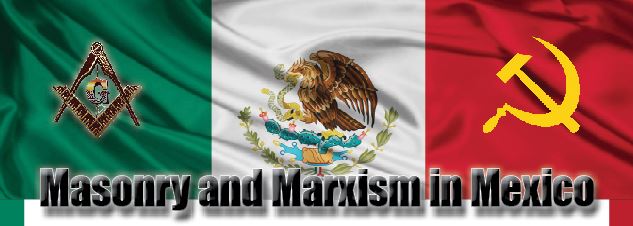
Louis Even wrote this article depicting a very difficult time in Mexico. In view of the current situation throughout the world, we have deemed it necessary to revisit history in order to help us to understand that the agenda being enforced today was long in coming.
In the last MICHAEL journal, we printed a narration of the apparitions of the Virgin Mary to Juan Diego of Mexico. She entrusted to him a mission and told him to relay a message to his bishop. The world famous sanctuary to Our Lady of Guadalupe originates from this message received from Our Lady.
We return to this subject once again to show how the Virgin of Guadalupe has kept her promise by answering the prayers and supplications of those who invoke her; she consoles and comforts them in their afflictions and labours. We have drawn information from a book written by Msgr. Charles-Eugene Roy, p.d., entitled; The Virgin of Guadalupe, Empress of the Americas.
Upon founding an organization, such as a religious Order, a person makes sure that the institution will continue even after his death. He establishes the order to this end and bestows upon it a method to ensure its permanence. This is the way it should be: great designs should survive those who conceive them.
It was so with the apparitions of Mary to Juan Diego in 1531. It was not only for the contemporaries of Juan Diego that Mary wanted a shrine built on Tepeyac, or only for the next three centuries in which time Mexico would continue to be a Spanish colony. She placed no limit on time, place or nationality. The conservation of her people’s faith was the main goal of her messages.
The first bishop of Mexico, Msgr. Zumarrraga, was a great propagator of the Madonna of Tepeyac, to the point that the freemason who was minister of Education during the presidency of Calles, Manuel Puig Casaurang, stated in a book he published in 1925: “In Mexico, one of the most powerful spiritual bonds, one of the clearest and best defined collective characteristics is without doubt the veneration that all Mexicans, even those who are unbelievers, have for the Virgin of Guadalupe, an Indian Virgin of our race and coloring. In effect, within the folds of her mantle decorated with roses, have remained hidden all the aspirations of the rich and the poor, the many desires of social and political improvements, mystical dreams and national adoration, that has become unquestionably a Mexican symbol. Our Virgin of Guadalupe is the symbol of Mexico.”
In 1736, an outbreak of the plague ravaged Mexico. After infecting many cities, it struck the capital. The precautions taken by the authorities proved useless. Public prayers were said; in just a few months 70 solemn prayer novenas were recited but the plague continued. 700,000 people died and there was general panic. Having reached such a high death toll, the population turned instinctively to the Virgin of Tepeyac, centering all their hopes on her.
The chapter from the basilica of Our Lady of Guadalupe firstly made a novena of prayer and penance, then a delegation of ecclesiastical delegates and laymen went to beg the Archbishop to proclaim Our Lady of Guadalupe the patroness of the city of Mexico and its surrounding areas and suburbs. The prelate agreed and immediately made the proclamation. At the same time, they said a solemn oath to celebrate the feast of Our Lady of Guadalupe on the 12th of December of each year. This is the anniversary of the great miracle in which the image of Our Lady appeared on the tilma of Juan Diego; they then took all the necessary steps to have this decision confirmed by the Sacred Congregation of Rites, which was completed in April, 1737.
On May 12th, the civil authorities agreed and the mayor proclaimed Our Lady as the patron of the city and its surrounding areas. On May 16th, a town-crier accompanied by drums and trumpets, the Minister of Justice and a great multitude announced this consecration to the population. It was a solemn day and a rebirth of hope for the country. As soon as the proclamation was made public, the epidemic lost its strength and the number of dead diminished. Many of the sick were healed: the Virgin of Guadalupe had liberated her people from the deadly epidemic.
 Our Lady is everywhere
Our Lady is everywhereFrom that moment onward, the devotion of the Mexican people for the Virgin was intensified even in the most remote parts of the country. Numerous churches in Mexico were dedicated to Our Lady of Guadalupe. Where she could not be proclaimed as the primary patroness because parishes must each have their own patron; she was made as a secondary patroness or her image was installed in a side chapel.
All the peasants and humble people were part of this great devotion; in the homes every room has a picture of the Virgin of Guadalupe. She is often found on the front door of the house or even in the garden. She is everywhere, in all forms; on simple printed images, on frescos and statues made of all types of material. Her image is stamped on coin money, fine china, crystal vases, medals, buttons, bracelets, broaches, rings; even on lottery tickets and commercial labels. An intellectual Mexican, who had no devotion and who was rather liberal, wrote in his book The Pride of Guadalupe, published in 1884, in which he spoke of the Virgin of Guadalupe:
“She has given origin to the most widespread, popular and deep-rooted cult there has ever been in Mexico from the 16th century to the present time... There is nowhere in the republic a city, large or small, village or settlement, that does not celebrate her with great feasts nor any Mexican who does not know of her. It would not be impossible to find, in the most distant areas away from the centre of the country, or in mountains where the most scattered tribes live apart, someone ignoring that our nation is independent; that we are living under a republican regime; that the president of the republic is called Don Someone: but what is sure and certain is that there is no one among the most savage of Indians or among the most abject and uncultured half-breeds, who ignore the apparition of Our Lady of Guadalupe.”
In reading the beginning of this text, one should not conclude that the population of Mexico lived in a state of continuous well-being, in a kind of terrestrial paradise, from the time of the apparitions of Tepeyac until our day. On the contrary, the history of Mexico is marked with vicissitudes, suffering, revolutions and persecutions. Our Lady had not come to exempt her people from the cross. She did not say to Juan Diego that there would be no more suffering, tears or weariness for those living in Mexico. Not at all. Instead, she said: “I will hear their tears and supplications; I will console them and lighten their labours and afflictions.”
Already the Indians were suffering from the harshness and exploitation from the Spanish conquerors. The laws emanating from the court of Spain were generally concerned with welfare of the Mexican natives and the conservation of their social structures.
However, the search for gain and power, the mentality of superiority of the conquerors over the conquered showed that the conquistadores, pioneers and Spanish businessmen cared little about laws. They were far from the royal arm. Furthermore, even the kings’ often ignored injustice, especially when it concerned favourites or persons distinguished for feats of arms in service to the crown.
The missionaries intervened to stop the exploitation of the natives by the Spaniards. The bishops even excommunicated some Spanish masters who, having reduced some natives to slavery, refused to emancipate them. (Slavery was still popular in many countries, including Christian countries.)
Throughout these cruel years, the Virgin of Guadalupe consoled the oppressed who had recourse to her protection. If one reads through historical descriptions of those years written by missionaries and Bishop Las Casas, who were great friends of the natives and their advocates to the authorities, it is horrifying.
The Virgin protected the natives and colonists who immigrated from Europe, not only during the time when Mexico remained a European colony but after its independence also. The independence that was claimed by the Mexican Liberators in 1810 was earned after eleven years of war. The Mexican empire was proclaimed in 1821 at the end of the war and Mexico was declared a republic.
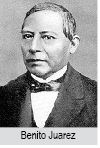 Masonic wind
Masonic windThis did not stop the agitators and Mexico soon had to endure fifty years of revolution.
The Masonic wind of secularization was blowing from France to many countries. In January of 1858, the president of Mexico, Benito Juarez, declared the Mexican republic, a secularized republic. The constitution was inspired by that of the United States; it proclaimed the separation of Church and State, freedom of speech and the press, equality for all by the abolition of the classes and the validity of civil marriage.
But while stating liberty for all, Juarez refused this freedom to the Church. Because he was reduced to material necessity for his administration, he wished to possess the material goods of the Church. He suppressed religious orders and oversaw the confiscation of their property. He had the ecclesiastical authorities watched closely, using various means to gradually diminish their influence. The cult remained legal in the interior of the churches but all exterior manifestations and devotions became illegal. Official education became laicized, religious education was tolerated in private schools only and the wearing of cassocks was forbidden.
Such was the reform of Juarez, which Pope Pius XI was to say later, was the worst that mankind had ever known.These restrictions deeply offended the Mexican people. Consequently, they were not very apt to follow the new regime forced upon them. Even under the long presidency of Porphirio Diaz (1875-1910), who was a dictator and a “Grand Master of the Great Symbolic Diet” in freemasonry, the Mexican Catholic Church consolidated itself and increased by 7 new dioceses. The number of priests rose from 1,500 to 5,000. The religious returned to their convents and monasteries and many new congregations were opened. The old Spanish tradition was in the blood of the people and remained still intact. The Catholics retained a good souvenir of the 35 years presidency of Diaz, from whom they could have received a much different treatment. Let us add here that Diaz left freemasonry in his last hour and died in the Catholic faith.
It was after Diaz died that the period of religious persecution began for the Mexican Catholics and the Virgin of Guadalupe continued to shelter them under her mantle because of their great devotion to her.
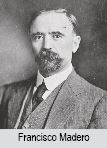 Persecutions
PersecutionsIt is the year 1910. The enemies of the Church were not too pleased by the lax attitude of Diaz, a less indulgent government was needed and they would see to that at the next election.
It was not the people who wanted to destroy the Church in Mexico. Just like in Spain, the ideas of the free-thinkers of France had penetrated into the cultural life of the Mexican elite; books were imported from France for higher education. Some cultivated Mexicans appeared proud of being able to read French, as well as Spanish, and to finish their education in Paris. It was among these ranks that freemasonry would pick men in order to facilitate their access to the government of the country.
Francisco Madero was one of these men. He was a Creole (half-breed) of small stature but impetuous and ambitious by nature. An old student of the Jesuits, he had received a good education but had since delved into spiritism and radicalism. He had followers as well. Around him were young intellectuals such as had been formed by two generations of lay education. His influence grew through the publication of a book and several speeches throughout the country. A disturbing agitator, he had been put under surveillance by President Diaz and even imprisoned for a month by the governor of the State of San Luis Potosi – which only served to make him a martyr in the eyes of his followers.
Then the elections of 1911 arrived. The varied party chiefs, no doubt in opposition to the ruling order, carried Madero to power. But the function of governing a country surpassed his capacities. He soon fell under the hand of an assassin.
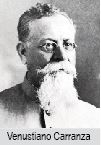 His successor, Venustiano Carranza, was more firm but not more disciplined. It was complete anarchy and violence that ruled the day, with the Church as the main objective. Religious persecution broke out in 1913 of which Father Ledit, a Canadian Jesuit, wrote:
His successor, Venustiano Carranza, was more firm but not more disciplined. It was complete anarchy and violence that ruled the day, with the Church as the main objective. Religious persecution broke out in 1913 of which Father Ledit, a Canadian Jesuit, wrote:
“It was a sort of revolutionary orgy against all that recalled discipline and moral law. Confessionals and statues were burned. Nuns were violated. It was horrible. In certain localities, drunken mercenaries gave extravagant orders, confession was authorized only to the dying and only on the condition that this confession be made out loud and before a government employee. In other places, celebration of Mass was forbidden. Numerous priests were shot. Almost all religious colleges were closed... All bishops, except one who benefited from the protection of the caudillo (military leader) of the South, decided to leave Mexico in protest against the regime imposed upon them.”
A Constituent Assembly opened in 1917 to give the country a new constitution. It was evidently drawn up in the revolutionary spirit of the hour. In the assembly debates, the clergy was called abject, guardians of ignorance, corruptor of morals, etc.
One of the constituents approved that churches be burned, sanctuaries confiscated and even that a few monks be hung. Another added: “If the ropes to hang the tyrants are lacking, we will braid some out of the guts of the priests.”
The new constitution resumed and intensified the non-religious clauses of the preceding ones which had not been strictly applied: compulsory lay education for all and interdiction of cults outside of sanctuaries. It forbade religious vows and communities. It deprived Mexican citizenship to whoever did not accept this constitution.
Father Ledit remarks that the Mexican constitution of 1917 inspired the writers of the soviet constitution the following year in Russia. This meant that Lenin’s Bolshevik clan, while waiting for a chance to throw itself upon Russia, a Russia sinking fast in military defeat and interior collapse, were keeping abreast of what some comrades of the same type of demonism were accomplishing in Mexico.
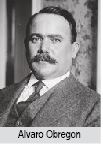 In 1920, a coup d’etat occurred: General Alvaro Obregon had President Carranza assassinated and took his place. It was not the end of the persecution, quite the opposite. Obregon, an impious man without scruples, had already distinguished himself in that regard. In 1912, he had desecrated a cathedral (in Guadalupe) using it as quarters for his troops. As mayor of the city of Mexico in 1916, he had assembled all the priests, declared them prisoners and subjected them to horrible treatment.
In 1920, a coup d’etat occurred: General Alvaro Obregon had President Carranza assassinated and took his place. It was not the end of the persecution, quite the opposite. Obregon, an impious man without scruples, had already distinguished himself in that regard. In 1912, he had desecrated a cathedral (in Guadalupe) using it as quarters for his troops. As mayor of the city of Mexico in 1916, he had assembled all the priests, declared them prisoners and subjected them to horrible treatment.
After becoming president of all Mexico, he governed by applying the persecution clauses of the new constitution with vigor. The red flag was raised on the steeple of the cathedral of Morelia; an image of Our Lady was slashed in the interior of a church that was ransacked, while the police frightened away the Catholics who wanted to hold a ceremony of reparation by firing gun shots in the air. The bishop’s palaces of Guadalupe and Mexico were bombed.
The Catholics were suffering because of this persecution against their priests and the desecration of the sanctuaries.
There is, however, one sanctuary that the government did not dare touch, a church which it did not attempt to close: the basilica of the Holy Virgin of Guadalupe. The government was aware that if it touched the basilica, the furor of the population would flare up, defying the police and all of their strength. The people would defend the Madonna, allowing themselves to be massacred rather than to surrender.
It was a great thorn in the side of Masonry and of their man in the presidency. In all evidence, the devotion of the population for this splendid and rich basilica was hanging on the presence of the miraculous picture, a gift from the Virgin Mary herself. Its preservation throughout these nearly four centuries was in itself a miracle. The crowds continued to flow to the national sanctuary, finding at the feet of their Madonna, a source of hope in these years where hell seemed to triumph in their beloved country.
The Masons did not cease to suggest to the persecutors: “Get the venerated image out of the basilica and you will soon see the fervour of the population for this sanctuary fail; you will then be able to confiscate it with its precious treasures.”
Easily said but how do you take an image out of a busy church, an image that weighs close to a ton, due to the rich frame of pure gold?
An anarchist named Luciano Perez was appointed to undertake the task. He thought it would be sufficient to plant a time bomb in the centre of a huge bouquet of flowers and deposit the bouquet in a good place, destroying the picture forever without taking it out of the basilica. It would be a total victory!
The anarchist put his plan into execution on the 14th (or 24th) of November, 1921. As the faithful always brought an abundance of bouquets, often very large ones, to Our Lady, it was not hard to place the bouquet with the bomb close to the frame. The explosion took place at the minute indicated: a tremendous explosion drew a crowd of anxious Catholics towards the basilica.
What did they see as they entered? Fragments of broken glass were scattered on the floor; pieces of the marble altar sown in all directions; the heavy crucifix surmounting the altar was lying, twisted, amongst other debris. But raising their eyes towards the beloved and venerated picture, they saw it in its ordinary place and examining it closer, observed it had suffered no harm. There was not even a crack in the glass of the frame.
The sorrow which had gripped the hearts of the people at the sight of the damage was forgotten. Relief prevailed and was expressed in sincere prayers of gratitude. The material havoc in the basilica could be repaired but the destruction of the celestial image, which was beyond all human achievement, would have been irreparable.
Hell, which hoped to triumph over the devotion of the Mexicans for their Virgin of Guadalupe, served only to add a new miracle to the history of the marvellous picture.
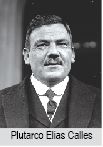 Even to martyrdom
Even to martyrdomIn this same month of November 1921, the presidency passed into the hands of Plutarco Elias Calles, who had been designated by Obregon. The name of Calles will remain in the religious history of Mexico, spurned as that of Nero or Diocletian in the history of the Church under the Roman emperors.
Born of a Jewish father and a Mexican mother, Calles had been a school teacher. He had also participated in the persecution of priests under the presidency of Obregon. But he went much further than his predecessor. He had sworn to destroy the Catholic Church in Mexico. He put bishops in prison, uttered insults against the Pope and declared himself the personal enemy of Christ.
“The Church has only one thing to do: disappear… We must uproot from Mexican soil all outworn religious ideas… We must undertake the terrible struggle against the past, against all the things which we must cause to disappear forever from the surface of the earth… The government is determined to execute its program without taking the slightest notice of the caretaker’s wincing or the protests of the lazy monks. Three times in my life I have met Christ on my path and three times I insulted Him.”
The implementation of laws of June 24, 1926 added even more severe interdictions to anti-religious laws that had already been promulgated and punished the infractions even more seriously. The religious cult came to be forbidden not only in sanctuaries but even in private homes. The various states of Mexico had to set a limit to the number of priests allowed, according to the population. In certain areas, not more than one priest was allowed per 3,000 residents; elsewhere only one per 5,000; still elsewhere only one per 30,000 or even 50,000! Holy water was forbidden. Images or statues had to be placed high enough or enclosed in nooks, so the faithful could not kiss them and many other absurd regulations. A bishop from Tabasco received the order to marry or to leave the country; he left.
Because of the impossibility of exercising their ministry, the priests received the order from their bishops, approved by Pope Pius XI, to suspend the exercise of the cult, beginning from July 31, 1926. The faithful rushed to the churches to receive the sacraments of Penance and the Eucharist for the last time. Churches were draped with black as a sign of mourning. The tabernacles were emptied and the doors remained open.
Lay people organized themselves to continue certain religious practices in the churches without a priest: prayers, hymns, rosaries, pious readings, and catechism.
The priests who continued their ministry in hiding did so at their own risk. To be caught would mean prison or even death. In Mexico, 10,000 police agents traveled through the streets hunting recalcitrant priests.
By November 1, 1926, Calles was boasting before Congress of having already closed 120 colleges and 42 Catholic churches, filling prisons with priests caught celebrating Mass, and of having more than 500 priests killed.
It was an era in which the Church in Mexico had to go underground, martyrs were numerous. The bishops, apart from a few who were able to hide, had to flee or were deported.
Faced with this satanic outburst, Pope Pius XI was consoled to learn about the heroic fidelity of thousands of Mexican Catholics, who were made to choose between apostasy and cruel chastisements, often even put to death for their faith. The Pope wrote on November 18, 1926:
“It is impossible for us to delve into individual cases. We insist in letting you know one thing, the members of Catholic associations are so unafraid of suffering, that instead of fleeing, they seek danger and rejoice when they have to suffer ill treatments on the part of their adversaries. It is a magnificent spectacle that is given to the world, to angels and men! These are facts that are worthy of eternal praise. Numerous are the Catholic leaders, the women and young people who were arrested and dragged by soldiers through streets, shut up in filthy prisons, severely punished and chastised.
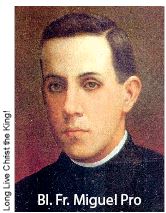 “Furthermore, some of these young people and adolescents, and tears come to our eyes as we report this, voluntarily met death with their rosary in hand, the invocation of Christ the King on their lips. To our virgins enclosed in prisons, the most indignant outrages were done, and this was made known in order to intimidate others and make them fail in their duty…”
“Furthermore, some of these young people and adolescents, and tears come to our eyes as we report this, voluntarily met death with their rosary in hand, the invocation of Christ the King on their lips. To our virgins enclosed in prisons, the most indignant outrages were done, and this was made known in order to intimidate others and make them fail in their duty…”
One of the most famous martyrs was Father Miguel Pro, a Jesuit whose cause was introduced in Rome to the Sacred Congregation of Rites in 1952. (Editor’s note: Fr. Pro was declared blessed in 1988 by Pope John Paul II). Calles ordered Father Pro’s death himself. When objections were made to Calles that this would make the priest a martyr, he cried out: “Father Pro a martyr? We must set an example for all of this scum? Formalities are not what I want but an execution! No hearing, nothing, what I want is death! I gave the order; all you have to do is obey! To the devil with your records!”
The persecution continued until the successor of Calles to the presidency, Emilio Portes Gil, a freemason lawyer and opportunist, judged the time right for an amiable truce. This was concluded on June 22, 1929 and announced by Pius XI himself.
It was a relief and joy for the population when they saw their bishops and priests return to reopen the churches and again have recourse to the sacraments.

So the fourth centenary of the apparitions of Tepeyac brought crowds to the national sanctuary. The archbishop of Mexico gave an enthusiastic speech. This rejoicing of the Church excited the fury of freemasonry. President Gil saw himself being accused by freemasonry of weakness and treason. The anti-religious regulations started again. Once again, statues and images were snatched from churches and thrown to the fire. Profane monthly feasts were introduced to attract the masses, preferably on religious feasts: cocoa feast, rice feast, milk cow feast, etc. Here the ungodly customs of Moscow were imitated, ridiculing sacred things by blasphemous acts such as giving God’s name to a bull, the name of Christ to a donkey and the name of a Pope to a pig.
It was a difficult time when the Pope had to have recourse to prayer and patience in order to navigate through these dangerous times. The most disquieting dangers came from the formation of popular attractions and indoctrination of the youth in movement of Marxist beliefs. This was especially under the successor of Gil, President Lorenzo Cardenas (1934-1940). Children were subjected to a socialist, sexual, proletarian education.
The firm and lucid Pope Pius XI followed the situation closely, in Mexico as well as in Spain where war against the Church was beginning with the implementation of a republic and in Russia where Stalin was waging a pitiless war against religion. Pius XI had given the Mexican bishops directives which certain among them did not estimate from the beginning: they renounced even before rallying.
Peace returned with the end of Cardenas’ septennial in 1940. But in what condition did the Church find this demonstrated in Mexico, after 130 years of unrest, of which 30 of them were open persecution: persecution that cost a million and a half lives?
If the persecution had made martyrs, it also left many wounds to the faith. A great number of people, in cities and rural areas alike, had become accustomed to avoid going to Church. The absence of priests, of sacramental and pastoral ministry had deprived the population of religion and education. Ignorance was considerably widespread. The marital situation of many households was irregular; the long closure of seminaries had caused a shortage of priests.
The Church resolutely took the task in hand and the lay elite, always growing in numbers, courageously aided in the great work ahead. Diverse forms of Catholic Action were seen recruiting members and the development of Catholic works, such as the Apostolate of Prayer, Legion of Mary, Aggregations of the Holy Sacrament, nocturnal adoration, Third Orders, etc.
Vocation societies reopened and sustained the seminaries. The Society for the Enthronement of Our Lady in factories and the Movement of the choral society started with enthusiasm.
The Movement that organized pilgrimages at Our Lady of Guadalupe became popular once again. Inaugurated in 1940, with pilgrimages of 8,000 workers, it reached 750,000 pilgrims workers by 1952 to various pilgrim sites throughout Mexico. Over 350,000 were to Guadalupe: it took seven hours for the crowd of workers to cross the city and the march in front of the miraculous image lasted from 3 o’clock in the morning until 5 at night.
Here was something to discourage the persecutors of the country, something to kill any thoughts of starting a new war with the Church who, after 35 years of effort, resulted in such a success!
And these were only the workers pilgrimages, there were also pilgrimages organized by other groups.
To raise the level of religious education, there emerged the Corporation of Mexican Students, with the Spiritual Exercises of St. Ignatius as the principal method of preparation. Four free normal schools were founded to give formation to the professors of free schools.
But we wish to elaborate here especially on the magnificent Catechist Movement, with a few details taken from the book by Msgr. Charles-Emile Roy. This Movement interested us particularly, because it seemed to us that something like this should be done in Canada, where the Roman Catechism has been banished from our schools. It has been substituted by a catechesis of ignorance, of deviation and heresies; like a dilapidated garment full of holes, covered with the mantle of Episcopal approbation.
Emerging from the persecution, Mexico was facing the following situation on the primary school level.
About half of the children of this age, say 3 in 6 million, attended school. Of these 3 million, appreciably half were still going to official lay schools, receiving no religious education whatsoever. It can be said therefore, that four and a half million were only able to receive religious education from their parents: these children were emerging from religious famine.
Catholic Action organized a central Commission for Religious Education, the success of which was remarkable and became immediately permanent. Here are a few notes which give an idea. They date from 1956 but the example remains eloquent.
“The Catechetic Movements formed more than 15,000 catechists, who teach more than 600,000 children and 150,000 adults.
“These 15,000 Catechists are almost totally made up of women and young girls (only about 600 men).”
The author who writes has closely studied the Catechetic Movement of St. Francis Xavier of Mexico. The 3,000 catechists reached 60,000 children divided into 250 centers, which consists of half of Mexico City itself and the other half in surrounding areas.
“They must all be members of congregations dedicated to Our Lady. Their Marian congregations were erected under the patronage of Our Lady of Guadalupe.
“They belong to all classes of society but the larger group are office employees who consecrate their only free day of the week to teaching the catechism.
“About 75 percent of the catechists attend Mass and receive Communion daily.
“On their catechism day, they leave by bus early in the morning and pay their own fare, since everything here is based on devotion. At the end of the route it often happens that they must walk a few kilometres on foot, and it is not the oldest that are the less courageous.
“Having arrived at the centre, they teach catechism under the supervision of the directress. They spend a joyful day in parishes for which they are responsible. At night, they return home, to take up their work the next day at the office.
“They pay everything from their pocket. They even buy gifts to distribute to winners of contests on the day when prizes are awarded and some are appreciably large. They knit at night in order to give something to a poor child.
“The formation is austere. It can be judged by these questions and answers taken from the catechist’s manual:
“Question – How can we solve the problem of the lack of catechists?
“Answer – By intensifying the spiritual life of the existing catechists: it is the only thing which gives them stability and constantly brings new recruits, showing them the necessity of the apostolate, the obligation of every Christian and member of the Church, the great promise of Our Lord to those who consecrate themselves to instructing others in teaching the way of truth.
“The supernatural formation of the catechist consists of a weekly holy hour, monthly recollection and annual retreats of six complete days of silence. The technical formation consists of two weekly classes of religion and one in pedagogy.”
All these works, the zeal of priests and laymen of both sexes are the work of mankind, placed under the protection of Holy Mary of Guadalupe who has certainly played the greatest part in the revival of the Mexican Church. She had helped and sustained her people through a dangerous menace to the conservation of its Faith. She helped it no less powerfully through a remarkably fast re-establishment.
The author that we are following here draws three characteristics of the action of the people in the work of restoration:
Total absence of all human respect, a solid and convincing piety in everyone. Feminine morality which stands out clearly against the general unconstraint. Apostolic fervour.
In developing the second point, he quotes the following wish of Father Francisco de Florencia, taken from a piece written around 1695. It is always to the point and we recommend it as a meditation to all women and young girls who wish to care for their souls and those of others:
“May all women, regardless of which class they belong to, find in this image of the Sovereign Lady (the Virgin of Guadalupe) an example of purity and a mirror of modesty. May they imitate her beneficent reserve and the charm of her modest attire. May they learn from her in what way their life can be more beautiful, what they can discard in their manner of dressing and what must be set aside to prevent all scandal in their way of life. As a crystal shines with its varied rays, this blessed image projects rays of purity and honour as well as light and magnificence.”
